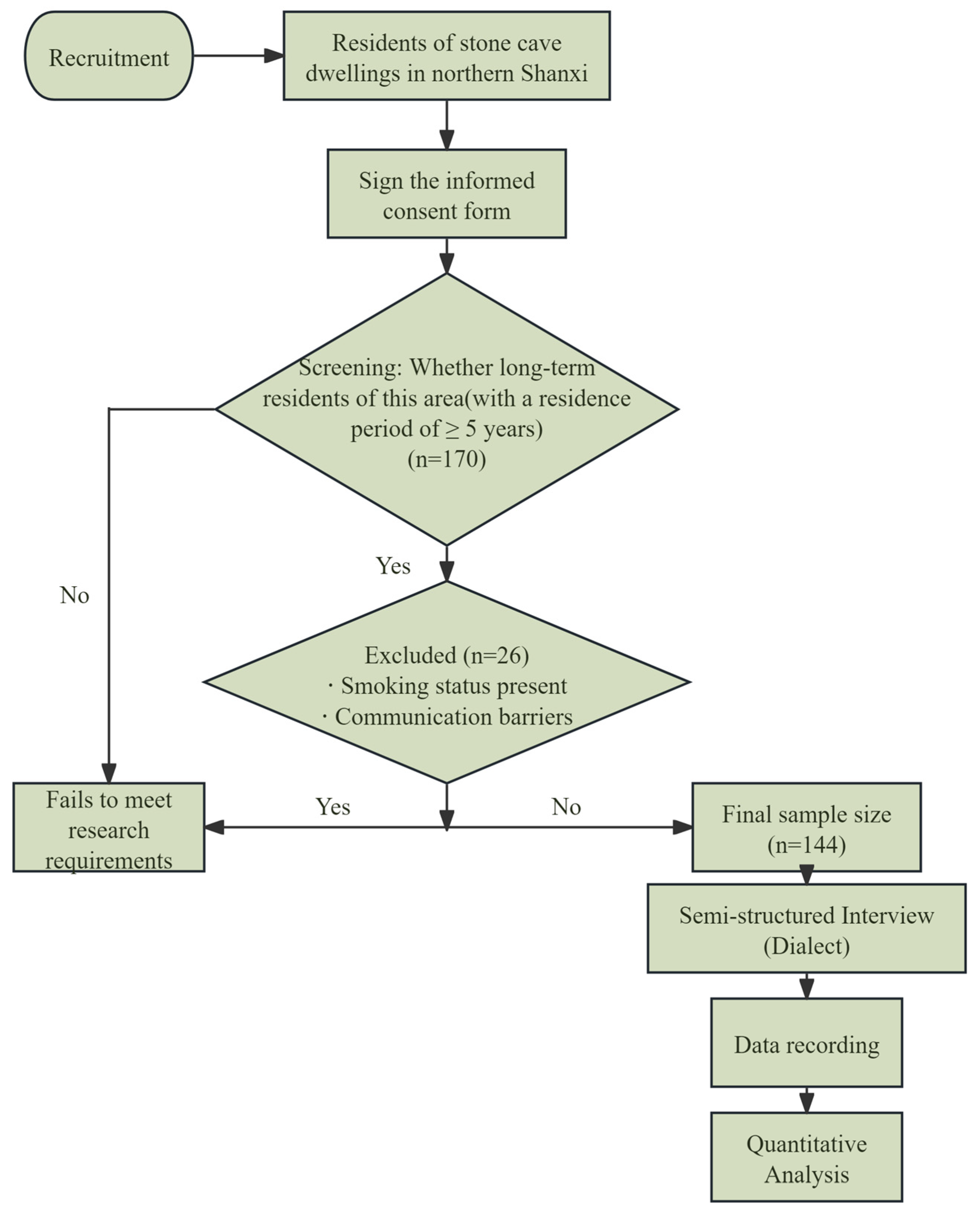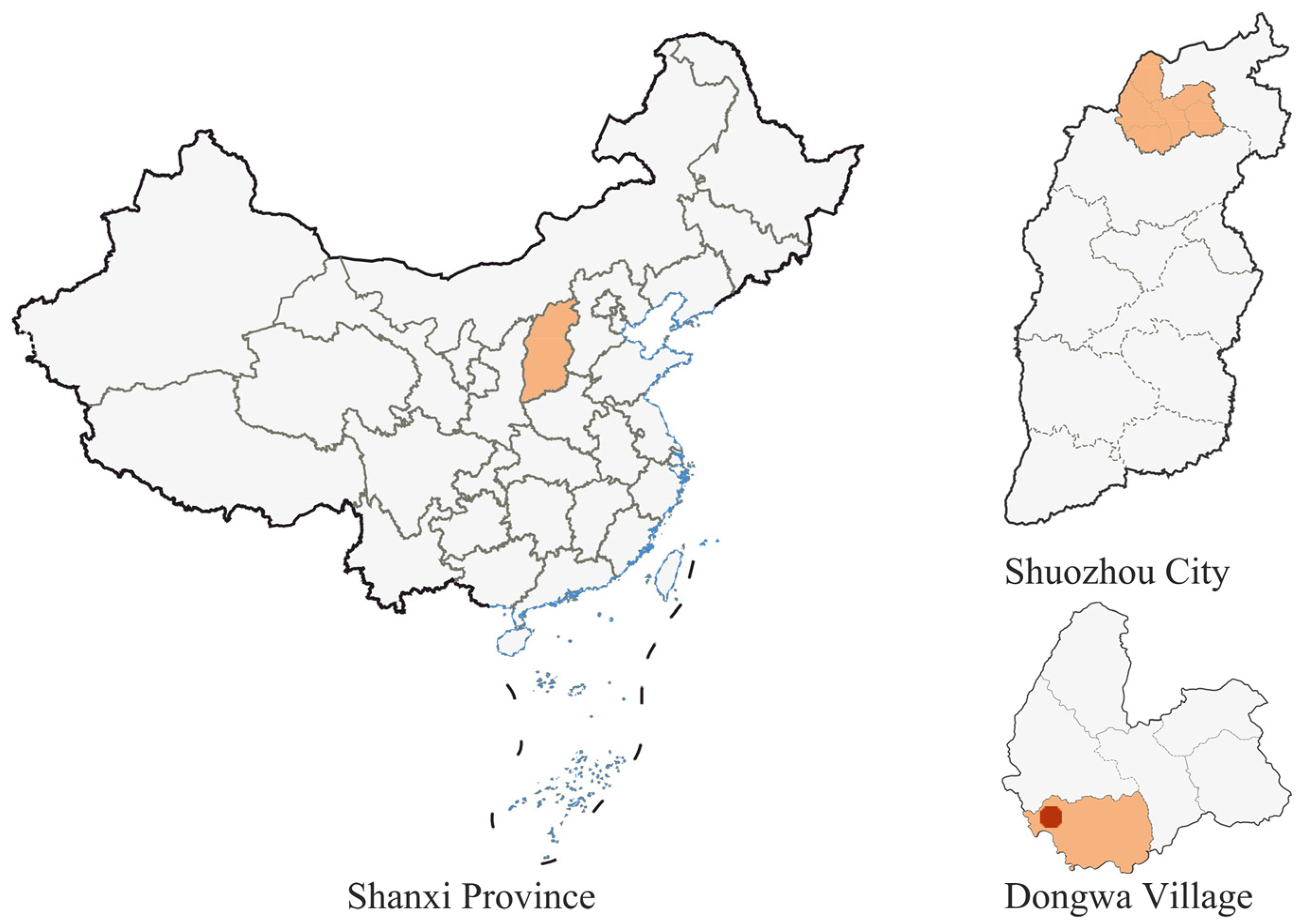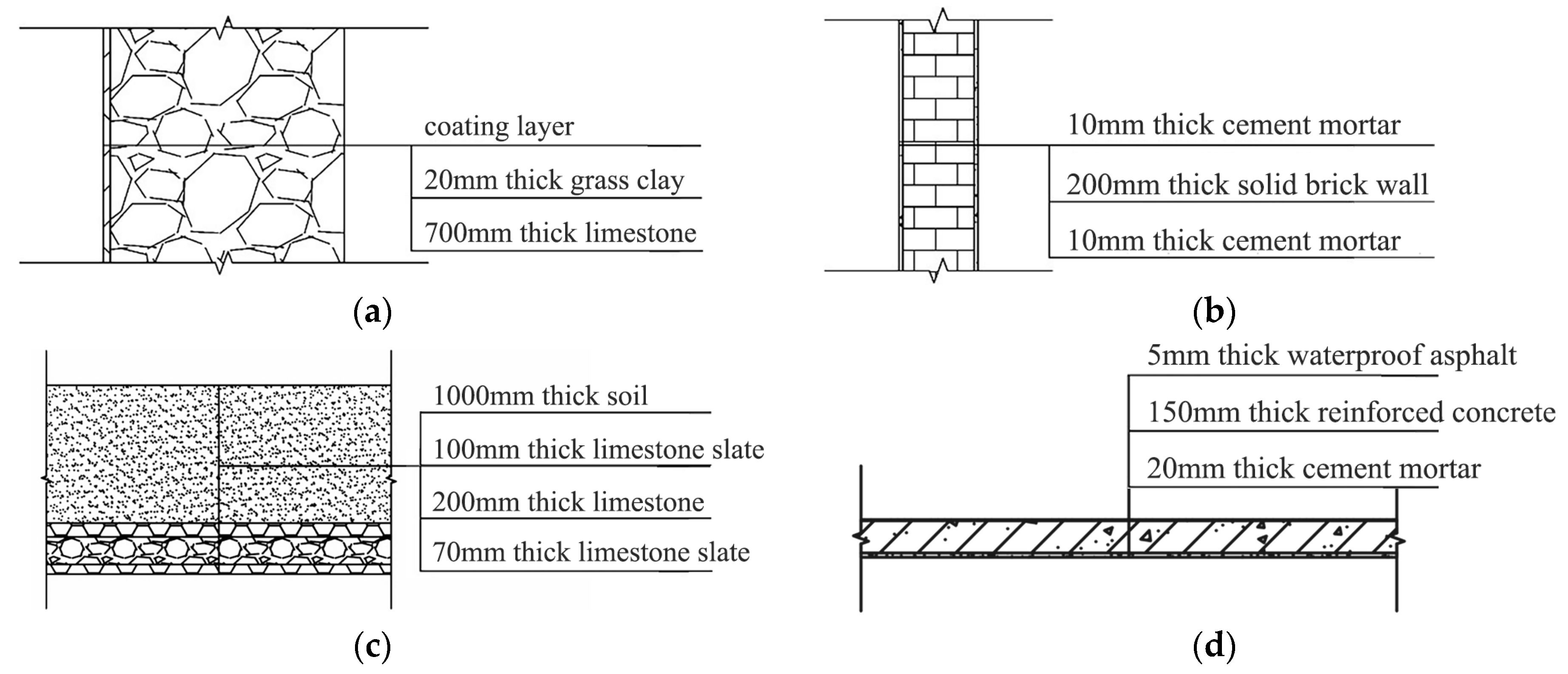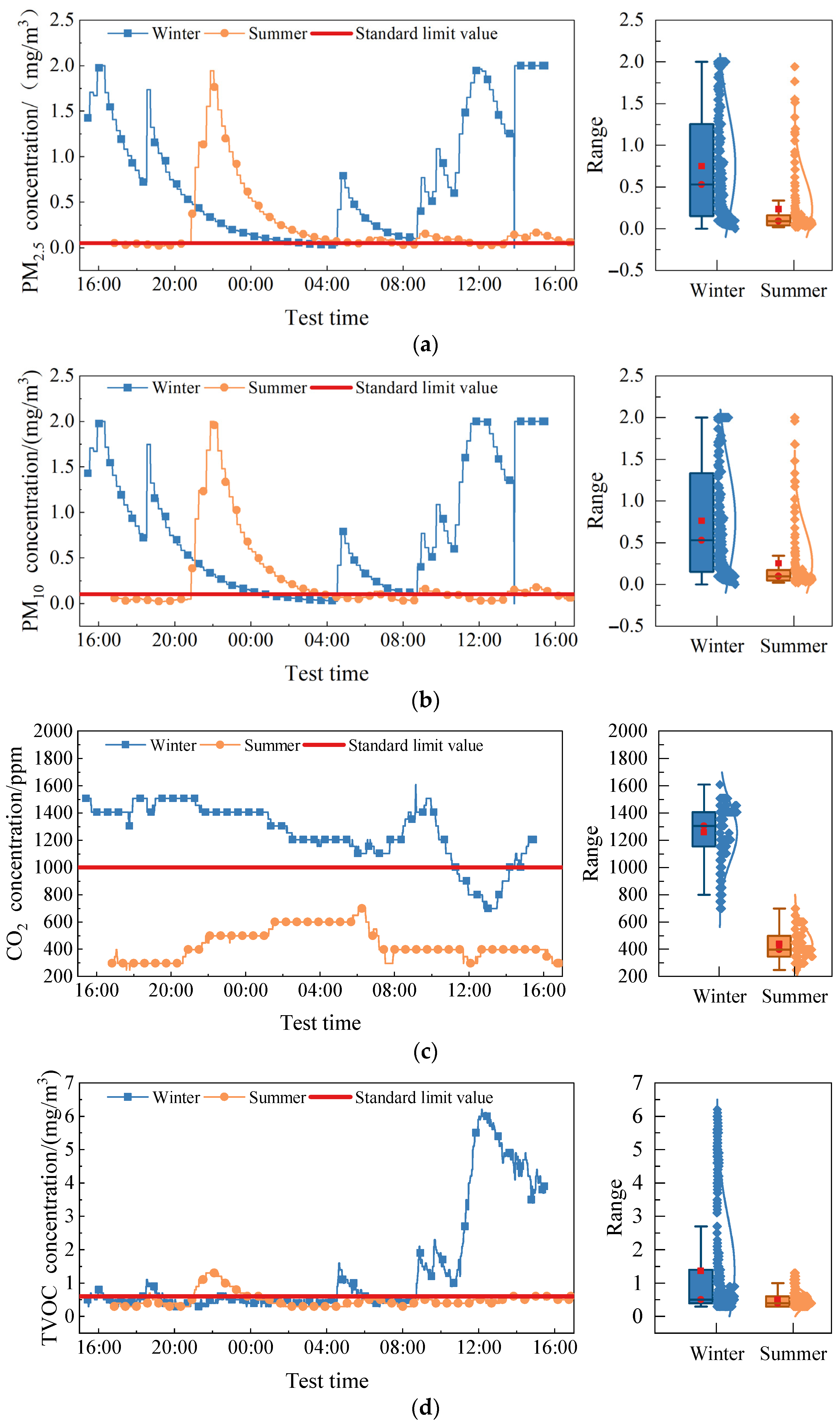1. Introduction
Rural regions in northern China predominantly utilize decentralized heating methods, including heated kangs, firewalls, and stoves. The energy consumption is high, but the heating effect is inadequate, resulting in a harsh indoor thermal environment during winter that fails to meet basic living requirements [
1]. Inadequate fuel combustion significantly impacts air quality and poses health risks to residents, particularly the elderly, who are more susceptible to respiratory diseases and allergic reactions [
2].
As a quintessential form of traditional northern dwellings, cave dwellings hold significant potential for rural revitalization and cultural heritage preservation [
3]. However, existing research has mainly focused on cliff-side cave dwellings in northwestern China, with limited studies on independent stone cave dwellings [
4]. Under varying climatic conditions [
5,
6] and architectural types [
7,
8], residents’ subjective perceptions of comfort can differ substantially. Consequently, it is essential to investigate indoor environmental conditions across different regions and cave-dwelling types.
Independent stone cave dwellings, characterized by their freestanding structure and stone masonry, differ markedly from traditional cave dwellings in form and material. They represent a distinctive traditional residential type in northern Shanxi. Affected by urbanization and rural population outflow, the number of such traditional dwellings continues to decline without receiving adequate attention or protection. Currently, systematic investigations and research on the indoor thermal environment and air quality of such dwellings remain scarce.
In recent years, with the in-depth implementation of sustainable development concepts, China has shifted its policy on traditional residential preservation from “demolishing old structures to build new ones” to “optimizing through preservation”. Meanwhile, the advancement of rural living environment improvement, beautiful countryside initiatives, and energy transition strategies has created a favorable policy context for the green renewal of traditional dwellings.
Against this backdrop, this article selects the independent stone cave dwelling located in Dongwa Village, Shuozhou City, as the subject of study. The main objectives of this study are as follows:
Measure and analyze the heat transfer coefficient and thermal inertia index of building envelopes to determine the thermal performance of residential buildings and the daily fluctuation characteristics of indoor temperature and humidity.
Combine objective and subjective surveys with the PMV and TSV models to evaluate indoor thermal comfort levels, calculate thermal neutral temperatures and thermal preference temperatures, and analyze residents’ thermal adaptation capabilities and thermal environment needs under cold conditions.
Continuously monitor the dynamic changes in indoor pollutant concentrations during winter and summer to assess pollution levels and exceedance rates, systematically evaluate air quality grades, and reveal discrepancies between residents’ subjective perceptions and objective pollution levels.
This article presents research findings that offer a scientific foundation for enhancing stone cave dwelling design and improving indoor environments, while also serving as a valuable reference for the study of similar local architecture.
2. Literature Review
Driven by the dual impetus of rapid global urbanization and the sustainable development agenda, green development has become a core requirement for urban and rural construction [
9]. As important carriers of regional characteristics and cultural heritage, traditional dwellings hold both academic value and practical significance for indoor environmental research.
The indoor environment primarily encompasses two components: thermal environments and air quality. The indoor thermal environment encompasses several environmental factors influencing the human body’s perception of warmth and coldness, including temperature, relative humidity, airflow velocity, and radiative heat transfer [
10]. Currently, scholars at home and abroad have conducted in-depth research on the indoor thermal environment and thermal comfort of traditional dwellings in different climatic regions [
11,
12,
13]. Studies indicate that the right temperature and relative humidity levels contribute to bodily comfort [
14], whereas inadequate ventilation negatively impacts indoor air quality and relative humidity levels [
15]. Furthermore, the structure of the building envelope directly influences the indoor thermal environment [
16]. Portuguese granite dwellings achieve effective thermal stability through 80 cm-thick walls [
17]. Zhang L et al. investigated the thick walls of traditional earthen dwellings in Turpan, revealing their effective thermal inertia, which contributes to the stabilization of indoor temperatures [
18]. Regarding the evaluation of wall thermal performance, a relatively systematic research methodology has been established. Scholars mainly adopt quantitative methods, such as using internal infrared thermal imaging to accurately determine wall U-values [
19]. Eduardo R et al. applied the simplified hot-box-heat-flux-meter method to analyze the thermal performance of heritage building facades [
20], while Luca E estimated building heat transfer coefficients via non-contact methods [
21].
It is widely acknowledged that a comfortable indoor thermal environment is a key factor in residential energy conservation and sustainable development, as well as a crucial element in people’s pursuit of the built environment. Therefore, providing a comfortable thermal environment for residential buildings is of great significance [
22]. To improve building thermal comfort performance, scholars at home and abroad have conducted in-depth research from multiple perspectives. Federica R et al. adopted the aNSGA-II algorithm to carry out multi-objective optimization of building investment costs, energy demands, and operational emissions [
23]. Xu J explored the application potential of radiative cooling materials in regulating indoor thermal environments [
24]. Rui W combined XGBoost with genetic algorithms to propose a rapid intelligent optimization method suitable for thermal comfort in Beijing’s traditional courtyard houses [
25].
Furthermore, indoor thermal comfort, as a core indicator for evaluating indoor thermal environments, has become a focal point of current research [
26]. It directly reflects occupants’ subjective comfort perceptions within architectural spaces and serves as a critical consideration in building environment design. Thermal comfort is not only closely related to human health and work efficiency, but also significantly affects occupants’ behavioral performance [
27]. Currently, research in this field mainly uses the PMV-PPD index as an evaluation metric [
28]. For example, Wen X et al. analyzed and evaluated indoor thermal comfort levels under different heating systems using the PMV-PPD framework [
29]. However, numerous field studies have shown that PMV predictions often deviate from actual thermal sensation votes [
30]. Therefore, this study will comprehensively adopt both PMV and TSV evaluation methods to assess indoor thermal comfort more thoroughly and accurately.
Indoor air quality refers to the concentration of various components present in indoor air, while indoor air pollution indicates the concentration of different pollutant gases present in that air [
10]. Research indicates that indoor air quality is affected by multiple factors, including the lifestyle habits of residents and their heating methods [
31]. Ding Y’s research on rural architecture in Chongqing [
32] and Ferhat K’s study on Kazakh dwellings [
33] both confirm that residents’ living habits are the primary cause of indoor air pollution. Lin Liu, Ilie, A. M. C, and other scholars found that localized heating methods are associated with poor indoor air quality, and recommended targeted improvement measures for the heating season [
34,
35]. The influence of various heating methods on indoor air quality differs, with biomass boiler heating [
36,
37] and solar floor radiation heating [
38] demonstrating effectiveness in enhancing indoor air quality. Many residents currently possess a limited understanding of indoor pollutants. Zhang M’s assessment of indoor air quality in rural residential areas utilizing various heating methods in northern Shanxi, China, revealed that a majority of rural residents held excessively optimistic subjective assessments of indoor air quality concerning coal-fired boiler radiator heating and heated kang heating [
39].
Furthermore, a unified comprehensive evaluation method for indoor air quality is presently lacking. Methods frequently employed encompass gray relational analysis [
40] and fuzzy comprehensive evaluation [
41]. Wang Z et al. assessed indoor air quality in rural residences in Harbin, China, employing gray relational analysis and fuzzy comprehensive evaluation, concluding that gray relational analysis demonstrated significantly higher resolution than fuzzy comprehensive evaluation [
42]. Therefore, this study employed gray relational analysis to evaluate the research subjects.
3. Materials and Methods
The methodology flowchart for this study is shown in
Figure 1.
3.1. Location and Climate
Dongwa Village is situated in Limin Town, Shuozhou City. The majority of houses in the village consist of independent stone cave dwellings, which are enveloped in a substantial layer of soil. Dongwa Village is situated in the transitional zone between the Loess Plateau and the Northern China Plain (
Figure 2), as per “GB/T 50824-2013, Energy-saving design standards for rural residential buildings” [
43]. The region experiences a typical continental monsoon climate, characterized by cold and dry winters and hot, windy summers.
3.2. Architectural Description
Based on field investigations, stone cave dwellings in northern Shanxi show high consistency in construction forms and indoor heating methods. Therefore, this study selected representative stone cave dwellings in Dongwa Village as the research subjects. These stone cave dwellings were created from locally sourced stone and loess, featuring distinctive designs for construction and well-adapted. The stone cave dwelling is constructed on level terrain, featuring ‘ox-leg’ buttresses composed of limestone and clay, with an arch positioned atop the buttresses and then covered with limestone flakes and soil to create a flat roof. The structure features an opening of approximately 3 m, a depth ranging from 5 to 6 m, wall thicknesses between 0.6 and 0.7 m, single-sided lighting, and double-leaf wooden doors, along with single-glazed wooden windows that are fixed and cannot be opened.
The primary characteristics of the stone cave dwellings in this region include simple construction methods and distinctive building materials. The construction process is efficient, with collaboration between villagers and local stonemasons, which effectively lowers costs. Additionally, the stone cave dwelling exhibits strong sustainability, as discarded stone can be naturally recovered into the environment or repurposed without adverse ecological effects. The utilization of stone in the construction of stone cave dwellings enhances their sturdiness and durability, resulting in a service life that spans decades to centuries, aligning with sustainable development principles.
3.3. Field Measurement
January is the coldest month of the year in northern Shanxi, coinciding with peak heating demand—during which both building energy consumption and heating pollutant emissions reach their highest levels. To investigate the indoor thermal environment and air quality characteristics of stone cave dwellings during this period, this study conducted questionnaire surveys on indoor thermal environment and air quality among residents of northern Shanxi’s stone cave dwellings in January 2024 and January 2025, with comparative testing carried out in July of the same years.
Stone cave dwellings in Dongwa Village are typically heated by cooking stoves connected to kangs. Monitoring was conducted during the winter heating season (11–17 January), with comparative testing in summer (22–28 July) to better understand variations in the indoor environment. Given the more severe indoor temperature and humidity conditions of stone cave dwellings in winter, this study focused primarily on their winter indoor thermal environment.
Throughout the monitoring period, all data were collected through 24 h continuous monitoring. The tested stone cave dwellings maintained a consistent stove-heated kang with windows closed, ensuring data consistency and comparability. Monitored parameters included indoor and outdoor temperature and humidity, as well as indoor concentrations of PM
2.5, PM
10, CO
2, and TVOC. Specific instrument models and accuracy specifications are detailed in
Table 1. All instruments underwent pre-test validation before formal testing to ensure measurement accuracy and stability.
The methodology for measuring point layout and parameter testing adhered to the “GB/T 18883-2022, Indoor air quality standards” [
44], which requires a measuring point at the center of any room measuring less than 25 m
2. In this study, all room areas measured were under 25 m
2, necessitating the establishment of a measurement point at the center of the testing room, as illustrated in
Figure 3.
For hot and humid environments, a measurement point is established at a height of 1.5 m above the ground in both the heated and unheated rooms of stone cave dwellings, with data collected at 10 min intervals. For air quality evaluation, a measurement point is located in the heating room of the stone cave dwelling, where indoor air concentrations of PM2.5, PM10, CO2, and TVOC are monitored continuously throughout the day, reflecting the daily habits of the residents. This study focuses more on the indoor heat environment in stone cave dwellings during winter, given the more severe conditions of heat and humidity in that season.
3.4. Subjective Survey
The survey findings are considered representative as all study participants were long-term residents of the area and spent a minimum of 30 min in the designated room. The format adheres to the sample size calculation formula:
where
is the minimum sample size,
is the normal standard distribution (
) at a confidence level of 95% and
, P is the prevalence/population proportion, usually taking a value of 0.5, and d is the tolerable margin of error.
The subjective questionnaire in this study was primarily designed with reference to ASHRAE Standard 55 [
45], covering participants’ basic information, subjective perceptions, current activity status, and clothing conditions (see
Appendix A for details). All survey participants are self-sufficient farmers with relatively similar economic levels.
Given that the research subjects were predominantly middle-aged and elderly individuals unfamiliar with electronic devices, traditional questionnaire surveys had limitations. To ensure data quality, this study adopted dialect-based interviews, with researchers transcribing responses on behalf of participants.
A simple random sampling method was used to select 170 households living in heated by cooking stoves connected to kangs stone cave dwellings as research subjects, and 170 questionnaires were distributed. Respondents were aged 19 to 85, with a male-to-female ratio of 1.2:1. During data processing, questionnaires were excluded if respondents smoked or if information collection was incomplete due to age-related hearing impairments, resulting in 144 valid responses. Statistical summaries of respondent demographics are detailed in
Table 2.
3.5. Data Preprocessing
This study used SPSS software 27.0 to test the reliability and validity of the survey questionnaires (
Table 3). Reliability analysis showed that the Cronbach’s α coefficient of the Indoor Thermal Environment Composite Scale was 0.700 (>0.7), and that of the Indoor Air Quality Composite Scale was 0.828 (>0.7). These results indicate that the questionnaire demonstrates good overall reliability and meets the requirements for statistical analysis. For validity, the KMO and Bartlett’s sphericity test results showed that the KMO value of the Indoor Thermal Environment Composite Scale was 0.733 (>0.6), and the KMO value of the Indoor Air Quality Composite Scale was 0.668 (>0.6), with a significance probability
p = 0.000 (<0.05). This demonstrates that the questionnaire data have good construct validity and are suitable for factor analysis.
3.6. Evaluation Method
3.6.1. Thermal Comfort Evaluation Method
The distinctive structural features of rural houses result in all building components, excluding the foundation, being in direct contact with the external environment. Inadequate insulation of building envelope structures can reduce internal surface temperatures, potentially resulting in cold radiation. The thermal comfort of rural residents primarily relies on air temperature and average radiation temperature.
The mean radiant temperature (
) was determined by analyzing the results of air temperature (
), globe temperature (
), and air velocity (
). The diameter (
) is 0.05 m, and the emissivity (
) is 0.95. The calculation method is presented in Formula (2):
Operative temperature (
) was selected as the evaluation index, incorporating the influences of air temperature (
) and mean radiant temperature (
) on human thermal sensation. When the indoor air velocity is below 0.2 m/s or the temperature difference between tr and ta is less than 4 °C, Formula (3) can be used:
Research shows that during winter in stone cave dwellings, occupants typically wear undergarments, woolen pants, sweaters, outer pants, coats, cotton socks, and cotton slippers. According to GB/T 50785-2012 “Evaluation standard for indoor heat and humidity environment of civil buildings” [
46], the thermal resistance of this clothing configuration is 1.5 clo. Villagers usually remain seated indoors during winter rest periods, resulting in a metabolic rate of 1.0 met for most individuals.
The PMV-PPD model is currently the internationally recognized method for evaluating thermal comfort. Developed by Professor Fanger based on ISO 7730 [
47] and ASHRAE standards 55 [
45], its core principle is that the closer the PMV value is to 0, the better the human thermal comfort. However, multiple field studies have shown that discrepancies often exist between PMV predictions and actual Thermal Sensation Voting (TSV) results. Therefore, this study uses both the PMV and TSV models to conduct a comparative assessment of thermal comfort conditions.
3.6.2. Gray Relational Analysis Method
Professor Deng Julong established gray system theory, a system science that focuses on the analysis of systems with little data and sparse samples, in the early 1980s. One of the primary methods, gray correlation analysis, looks for similarities between sequence curves. The correlation increases as the curves get closer together.
Preprocess the original data using the indoor air quality evaluation standard sequence as the reference sequence.
, the comparison sequence consists of the measured data
obtained from on-site testing experiments, where
.
The assessment of indoor air quality is significantly linked to the effects of environmental pollution on human health, with the classification levels presented in
Table 4 frequently utilized in environmental evaluations [
48].
The levels of pollutants in rural home indoor air quality tests varied greatly. Transforming components into dimensionless values reduces numerical differences. Weber–Fechner’s law, which states that the amount of the reaction is proportional to the logarithm of the stimulus:
, can be used to process pollutant concentrations to match human perception and compare them. A decibel-based matching calculation approach (Equation (4)) [
49] can better compare pollutant concentrations and estimate indoor air quality.
The formula is as follows: k is the constant that corresponds to the pollutant parameter; is the background value of each pollutant; and is the concentration value that was evaluated on site.
Follow these steps to process the evaluation criteria sequence [
50]:
The gray correlation coefficient between the reference and comparison sequences should then be determined using Equation (8), and the correlation degree should be determined using Equation (9).
The resolution coefficient,
(
), is typically taken as 0.5; the correlation degree,
, represents the degree of similarity between the
and
sequence curves; and the correlation coefficients,
, comprehensively reflect the magnitude of the correlation coefficients of all data points. A closer association between
and
is indicated by bigger values of
. An m × n order association matrix is formed by the relational degrees
, i
M, j
N.
5. Conclusions
This research assessed the indoor conditions of stone cave dwellings in northern Shanxi, yielding the following primary conclusions:
- (1)
Thermal Performance Analysis: Compared to conventional brick houses, traditional stone cave dwellings in northern Shanxi exhibit superior thermal stability (high thermal inertia index). However, their envelope insulation is severely inadequate relative to national standards. Quantitative analysis indicates that the thermal transmittance coefficients of their exterior walls and roofs exceed national limits by 4 times and 1.7 times, respectively, leading to substantial heat loss in winter. Additionally, indoor humidity levels in stone cave dwellings are excessively high, and the existing stove-heated kang system is inefficient, making it difficult to maintain baseline indoor temperatures. Recommendations include prioritizing thermal insulation upgrades for the building envelope to reduce heat transfer coefficients, while simultaneously improving the heating system and installing ventilation facilities. These measures would elevate indoor temperature and humidity to standard ranges (temperature ≥ 14 °C, humidity 30–60%).
- (2)
Thermal Comfort Evaluation: The theoretical thermal neutral temperature calculated by the PMV model (21.32 °C) is significantly higher than the actual thermal neutral temperature determined by TSV (10.96 °C). This clearly indicates that residents have achieved perceived thermal neutrality in colder environments through behavioral adjustments and physiological adaptation. It demonstrates the limitations of the PMV model in such specific environments, while the TSV model may better align with residents’ actual thermal comfort. However, residents’ self-reported thermal preference temperature (12.75 °C) remains higher than their TSV neutral temperature. This indicates that while residents passively adapt to the cold, they still express a clear desire for improved thermal environments. Therefore, subsequent improvement targets should be set at least at 12.75 °C, with the National Standard for Indoor Temperature in Rural Dwellings (14 °C) recommended as a more optimal goal.
- (3)
Air Pollutant Concentration and Quality Assessment: Under stove-heated conditions, the primary indoor air pollutants in stone cave dwellings are PM2.5, PM10, CO2, and TVOC. Monitoring data indicate that pollution is particularly severe in winter, with exceedance rates for PM2.5, PM10, and CO2 all exceeding 80%. While pollution levels decrease in summer, exceedance rates for PM2.5 and PM10 remain high (71.5% and 47.5%, respectively). A comprehensive evaluation based on gray relational analysis reveals that indoor air quality in summer is classified as “moderately polluted,” while it deteriorates to “heavily polluted” in winter. Notably, subjective questionnaire surveys show that residents’ self-reported perceptions of indoor air quality were generally more favorable than objective measurements, indicating insufficient awareness of actual pollution risks and weak sensory capabilities. Therefore, there is an urgent need to enhance public risk awareness through health promotion and science education, thereby building public support for implementing effective pollution control measures such as clean heating and improved ventilation.
However, this study still has several limitations. First, although stone cave dwellings, as traditional residential buildings, exhibit excellent thermal stability, their material structure has inherent flaws: the envelope has a high heat transfer coefficient, resulting in insufficient thermal insulation performance in winter. Second, most cave dwellings adopt stove-heated kang, which is highly polluting and subject to limited ventilation conditions. This is not conducive to pollutant diffusion, thereby exacerbating indoor air pollution caused by the use of non-clean energy. Third, restricted by research conditions, the sample size is limited, and the geographical distribution is concentrated. The proportion of elderly residents among the respondents is relatively high, and their environmental perception patterns formed through long-term adaptation may introduce group biases in subjective evaluations. In addition, field monitoring was mainly conducted in winter and summer, failing to systematically cover the transitional spring and autumn seasons. Future research needs to further expand the temporal scope of observations.

















